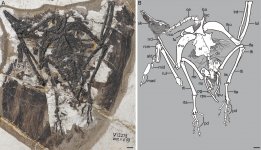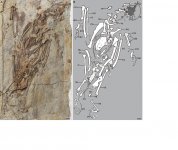Fred Ruhe
Well-known member

Min Wang , Zhiheng Li , Qingguo Liu & Zhonghe Zhou, 2020
Early Cretaceous ornithuromorph birds provide insights into the taxonomy and divergence of Yanornithidae (Aves: Ornithothoraces)
Journal of Systematic Palaeontology. 18 (21): 1805–1827.
doi:10.1080/14772019.2020.1836050
Abstract:
Yanornithidae is an Early Cretaceous ornithuromorph clade that preserves the oldest direct evidence indicative of a piscivorous diet in avian evolution. The family hitherto contained only a single genus Yanornis and two putative species. The yanornithids are readily distinguishable from other Mesozoic avians in having a long rostrum packed with numerous teeth. Despite the discoveries of dozens of specimens, little is known about the taxonomical and ecomorphological diversity of this clade due to a lack of comparative studies. Here, we describe two new yanornithid taxa, Similiyanornis brevipectus gen. et sp. nov. and Abitusavis lii gen. et sp. nov., based on two nearly complete skeletons from the Early Cretaceous Jehol Biota. We perform a taxonomical reassessment of yanornithids and rectify the assignments of published putative Yanornis-like materials. The results show that Yanornithidae contains three genera and three species, which demonstrate a wide range of limb proportions that exceed the degree seen in other L early ornithuromorph clades.
Enjoy,
Fred
Early Cretaceous ornithuromorph birds provide insights into the taxonomy and divergence of Yanornithidae (Aves: Ornithothoraces)
Journal of Systematic Palaeontology. 18 (21): 1805–1827.
doi:10.1080/14772019.2020.1836050
Abstract:
Yanornithidae is an Early Cretaceous ornithuromorph clade that preserves the oldest direct evidence indicative of a piscivorous diet in avian evolution. The family hitherto contained only a single genus Yanornis and two putative species. The yanornithids are readily distinguishable from other Mesozoic avians in having a long rostrum packed with numerous teeth. Despite the discoveries of dozens of specimens, little is known about the taxonomical and ecomorphological diversity of this clade due to a lack of comparative studies. Here, we describe two new yanornithid taxa, Similiyanornis brevipectus gen. et sp. nov. and Abitusavis lii gen. et sp. nov., based on two nearly complete skeletons from the Early Cretaceous Jehol Biota. We perform a taxonomical reassessment of yanornithids and rectify the assignments of published putative Yanornis-like materials. The results show that Yanornithidae contains three genera and three species, which demonstrate a wide range of limb proportions that exceed the degree seen in other L early ornithuromorph clades.
Enjoy,
Fred
Last edited:





